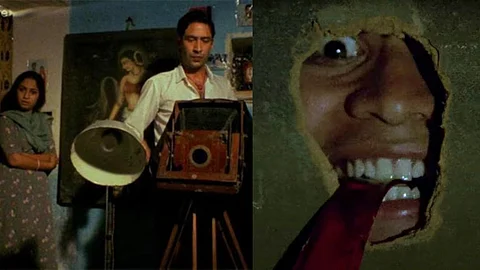
- HOMEGROWN WORLD
- #HGCREATORS
- #HGEXPLORE
- #HGVOICES
- #HGSHOP
- CAREERS
- ABOUT US
- CONTACT US

"Horoscope, dead frog, cloudy sky, the moon, radio program, caste reservation, bicycle, Mount Everest, women’s liberation, communism, sleeveless blouse, Yuri Gagarin, miniature book, Nitrogen fixation, man on moon, terrorist tadpoles, computer, biology class, turtles, Hema Malini, typewriter, sleazy magazines, hibernation, text inside nose, googly, James Bond, severed tongue...."
No, you're not having a stroke. This is the plot of an Indian cult classic film from 1988, as described by its first review on a film blog called The Seventh Art. Floating somewhere between avant-grade, postmodernism and a fever dream, Om Dar-B-Dar directed by Kamal Swaroop was also titled "the great Indian LSD Trip" by the same blog.
Set against the backdrop of Ajmer in Rajasthan, the disjointed, Tarantino-esque film is about a young schoolboy named Om who is struggling with the oppressive grip of reality and his eccentric family. Om, who rants about terrorist tadpoles and delves into dirty ponds in search of treasure, can hold his breath for a long time, a talent that he is famous for in his village and that also symbolizes his rebellion against life itself. But what's bothering him the most his is damn nose which always interferes with his sight as he tries to read. Swaroop's vision portrays the anxieties of adolescence, with Om's escapades serving as a vehicle to explore the protagonist's deep-seated fear of existence.
Despite not receiving a commercial release in India initially, Om Dar-B-Dar quickly gained international recognition through its screening at renowned film festivals, including a Berlin premiere. Its unconventional storytelling, unique visual style, and thought-provoking themes propelled the film to cult status, captivating audiences with its bizarre irreverence and making it a subject of study in film schools worldwide. It was on 17 January 2014 that the film finally graced Indian theatres after being granted a national release by the National Film Development Corporation of India (NFDC).
Over the years Indian filmmakers Anurag Kashyap, Imtiaz Ali, Resul Pookutty, Kiran Rao and Amole Gupte have all expressed their love for the film, with Anurag's film Dev-D even featuring the chaotic song Emosanal Attyachar that was heavily inspired by the Om Dar-B-Dar's track Meri Jaan. Swaroop's unassuming masterpiece is claimed by the director to be a story about Lord Brahma based solely on dreams and images that he "cannot think in words".
Revered for its surrealism and absurdism Om Dar-B-Dar can be seen as a response to India's serious and self-conscious art-house films prevalent during the 1970s and 1980s. By challenging the conventions of mainstream Indian cinema, the film offers a tongue-in-cheek satire of Bollywood's storytelling tropes, presenting an alternative perspective through its subversive themes and imagery. But more than anything, its nonsensical chaos, that makes you question what reality even is, is the greatest charm of the film.
You can watch the film below.
